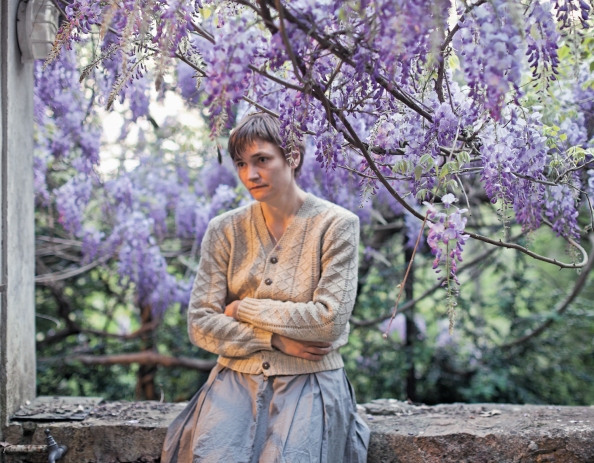Nikki S Lee is an American performance artist of Korean origin. She uses a camera to record her art, but does not consider herself a photographer (Bright 2011,41). Her typical images are a form of self-portraiture, ‘snapshots’ of herself taken by others with simple point-and-shoot cameras. Of her two major bodies of work, ‘Projects’ is very much a masquerade exercise and ‘Parts’, although apparently more self-referential , is still a performance of sorts. More recently, she has branched into film; ‘AKA Nikki S Lee’ is part documentary and part performance, in which she plays both the documentary-maker and the subject. (reviewed in Kino, 2006 and Davis, s.d.)
‘Parts’ (2002-2005) is the less controversial and easier to describe body of photography. Lee has herself photographed in ‘social snapshot’ situations with different men, prints the image then cuts the man out, leaving just a vestige such as an arm or a hand visible. (slideshow of examples here) Seen individually, these images appear as caricature ‘break-up’ pictures, including the three-sided border which makes it obvious that this is a cut image rather than poor framing. In the AKA film, she gets angry at one exhibition where the borders have been removed before framing in a mistaken attempt to tidy-up the photograph.
When several of the images are viewed together, we see something different. The same face (Lee’s) is matched with differing costumes, make-up and locations and we realise that there is some role-playing (masquerade) going on. Lee tells us (reported by Bright 2011, 41) that these are not break-up pictures but “… show how personal identity is is affected by other people and different kinds of relationships. … You can see that it is one person throughout and that her identity shifts and changes depending on whom she is with”. The use of ‘her’ rather than ‘my’ is significant and suggests that even when interviewed, Lee is role-playing.
‘Projects’ (1997-2001) is a set of interconnected (if only by technique) projects in which Lee adopts a particular group or subculture for a period of weeks or months, attempts to assimilate or blend in, then has herself photographed in persona with group members, by members of the group or passers-by, in the same snapshot aesthetic noted earlier. As before, individual images are unremarkable but viewing multiple images makes the role-play and deeper questions more obvious.
At the surface level, we are tempted to play a version of ‘Where’s Wally’, to identify Lee in each image. Her distinctively oriental features make this easier in groups where there is a racial stereotype (the WASPs of ‘The Yuppie Project’ or the African-Americans of ‘The Hip-Hop Project’ for example) and part of the controversy around her work comes from reviewers dealing with perceived racism (eg. Berger 2001 and Kim 2016)
There are challenges in attempting to fit the group visually. In ‘The Schoolgirl Project’, going back to Korea helps with facial features but Lee is noticeably older than the group. At the other end of the scale, she had to wear a mask and/or heavy make-up for ‘The Seniors Project‘ (it is reported that the group members ‘thought she was an elderly crackpot and gently humoured her’ (Cotter 1999)). It is her use of blackface in ‘The Hip-Hop Project’ that particularly attracts Kim’s venom.
Any masquerade project (apart from obvious drama in a formal theatrical setting, when we know what to expect) is going to be controversial, with accusations of voyeurism or exploitation. The language used by reviewers is interesting. The more neutral reviewers say little about the process by which Lee joins her groups; however Dalton (2000) who appears generally approving, refers to Lee ‘befriending’ the group, whereas Seamon (2011, reviewing Smith) in a book review says that Lee “… ingratiated herself with various subcultures …”.
The images appear primarily as a comment on the nature and identity of the group she is working with. Group members appear as subjects in the photographs, and Lee has either done her research or spent time assimilating in order to blend in as well as she does. Whether they comment Lee’s own identity is problematic. Clearly she is there, but my own reading is that she is playing a part. Ultimately, these are film stills with Lee as one of the actors.
References
Berger, M. (2001) ‘Picturing whiteness: Nikki S. Lee’s Yuppie Project’. Art Journal 60 (3), pp.54-57.
Bright, S. (2011) Art Photography Now.. revised edn. London, UK: Thames & Hudson.
Cotter, H. (1999) ART IN REVIEW; Nikki S. Lee [online] Available at <http://www.nytimes.com/1999/09/10/arts/art-in-review-nikki-s-lee.html> [Accessed 15/10/2017].
Dalton, J. (2000) ‘Look at Me: Self-Portrait Photography after Cindy Sherman’. Performing Arts Journal 22 (3), pp.47-56.
Davis, B. (s.d.) Cultural Karaoke [online] Available at <http://www.artnet.com/magazineus/reviews/davis/davis10-24-06.asp> [Accessed 15/10/2017].
Kim, E. (2016) Nikki S. Lee’s “Projects”—And the Ongoing Circulation of Blackface, Brownface in “Art” [online] Available at <http://contemptorary.org/nikki-s-lees-projects-and-the-ongoing-circulation-of-blackface-brownface-in-art/> [Accessed 15/10/2017].
Kino, C (2006) Now in Moving Pictures: The Multitudes of Nikki S. Lee [online] Available at <http://www.nytimes.com/2006/10/01/arts/design/01kino.html?ex=1317355200&en=ba68cca87c7383c1&ei=5088&partner=rssnyt&emc=rss> [Accessed 15/10/2017].
Smith, C. (2011) Enacting Others: Politics of Identity in Eleanor Antin, Nikki S. Lee, Adrian Piper and Anna Deavere Smith, Durham NC: Duke University Press [reviewed by Seamon, M. in unidentified journal]























 Wearing explains the process of creating the masks and the photographs in an extended Guardian piece (Wearing 2012). These are thick silicone masks, created by a mask-maker with training from Madame Tussauds, intended to remove the contours of Wearing’s face and almost every other piece of visible skin. This image is of the mask representing her sister, and includes coverage of the throat as well as the face.
Wearing explains the process of creating the masks and the photographs in an extended Guardian piece (Wearing 2012). These are thick silicone masks, created by a mask-maker with training from Madame Tussauds, intended to remove the contours of Wearing’s face and almost every other piece of visible skin. This image is of the mask representing her sister, and includes coverage of the throat as well as the face.